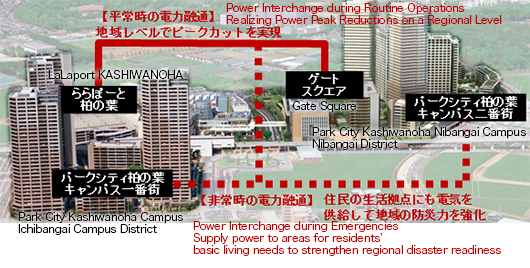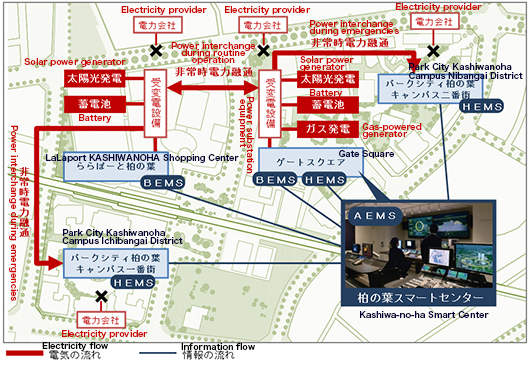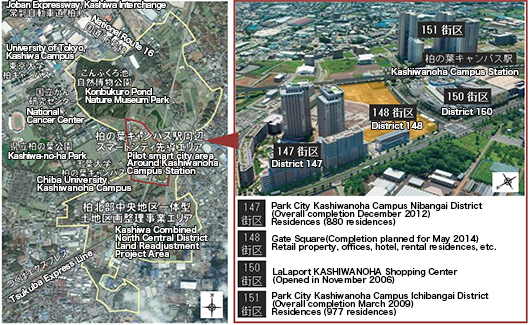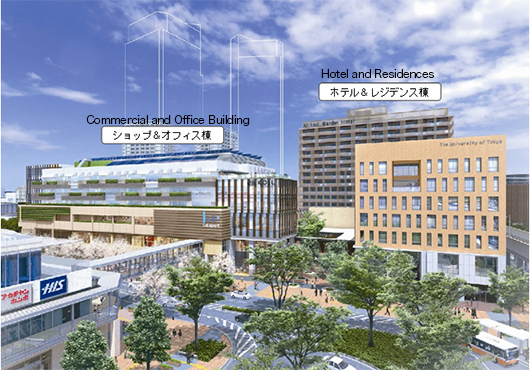
|
* Information contained in this news release is current as of its date of announcement. Be aware that information contained herein is subject to change without notice. |
“Kashiwa-no-ha Smart City,” Easy on the Environment, Resilient Against Natural Disasters
Japan’s First Smart Grid Application Sharing Power through Dispersed Power Supply
Realizing cuts in peak power demand on a community level and reinforced disaster readiness
April 24, 2014
Mitsui Fudosan Co., Ltd.
Mitsui Fudosan Co., Ltd. is moving ahead on Kashiwa-no-ha Smart City, a project aiming to create An Environmental-Symbiotic City, A City of Health and Longevity, and A City of New Industry Creation, where dispersed energy sources such as solar power generators or batteries are shared on a smart grid, due to gradually start operations from July 2014. This project will be the first instance in Japan where self-operated dispersed power sources or electric lines will be used to share power in districts serviced with public roads. Recently, power control technologies needed for this initiative have been developed, and approval gained from Japan’s Ministry of Economy, Trade and Industry to supply power as specified supply to an existing residential district in the wake of a natural disaster.
Overview of the Plan for Power Interchange in Kashiwa-no-ha Smart City
Cutting Power Peaks during Routine Operations
- Buildings in each district will be powered by dispersed power sources, such as through an electricity provider’s power grid or by solar power or battery, and this power will be shared across the entire district to realize cuts at times of peak power use.
- On weekdays, power demand rises in offices; thus the plan is for the LaLaport KASHIWANOHA shopping center to supply the mainly offices and hotels at Gate Square with power, while the reverse will apply on weekends when Gate Square supplies power to the commercial facilities at LaLaport KASHIWANOHA in response to its increased power demand.
- This initiative is forecast to cut power consumption on the regional level by approximately 26%, contributing to reduced energy use and lower CO2 emissions, while also having the economic benefit of lowering power bill costs for the two facilities by approximately \10 million annually.
Reinforced Disaster Readiness during Emergencies
- When supply from the power grid has stopped, the area’s disaster readiness capability is heightened due to electricity generators and electricity storage facilities supplying a specified supply to necessary facilities and equipment to maintain residents’ lifestyles.
- Specifically, this means using the power generator and electricity storage facilities at Gate Square to supply power for condominiums at Park City Kashiwanoha Campus Ichibangai and Park City Kashiwanoha Nibangai to power elevators (one for each building), common area lighting and other shared facilities such as meeting halls.

Artist’s impression of the power interchange (Aerial view of the area around Kashiwanoha Campus Station, including some partial digital synthesis)
Kashiwa-no-ha Smart Grid Features
Diverse Power Sources through Facilities Dispersed Regionally
LaLaport KASHIWANOHA is equipped with a half-mega solar power generator (output: approx. 500 kW) and by late June is schedule to have a large scale energy storage unit (capacity: 11,850 kWh, output: 1,800 kW). Gate Square, a mixed-use facility currently under development, will be equipped with a solar power generator (output: approx. 220 kW) a battery (capacity: approx. 3,800 kWh, output: approx. 500 kW) and an emergency gas-powered generator (output: approx. 2,000 kW).
A Smart Grid Model Compatible with Electricity Providers
A power supply device has been set up so that when conducting a power interchange through dispersed sources to the districts it can be controlled to ensure it is not mixed with power grid electricity supplied by an electricity provider. Solar power generation can fluctuate depending on the weather; therefore stable power supply is secured by combining it with a large battery. This is the first instance in Japan where solar power generation facilities have been approved as a specified supply under the Electricity Business Act. This system enables power supply through dispersed sources within the region without placing any burden on the power grid.
Realizing Area Energy Management
An Area Energy Management System (AEMS) has been built to connect each facility and the dispersed power sources through an ICT network. The AEMS collects data on power generation, storage, electricity use and such information as regional climate or disaster data, then analyzes this to estimate power demand, generation and storage capacity to formulate a plan for optimal power supply.
Kashiwa-no-ha Smart Center Establishment
The Kashiwa-no-ha Smart Center has been established within Gate Square as an area energy management base controlled by the AEMS. The Kashiwa-no-ha Smart Center will perform such tasks as observing regional electricity, controlling power generation and storage equipment and managing power interchanges. It will also conduct “behavioral navigation” by analyzing the energy use trends at each facility and transmitting advice on how energy use may be reduced.
Schematic of the Kashiwa-no-ha Smart Grid
(During Routine Operations)

Click here to enlarge
Schematic of the Kashiwa-no-ha Smart Grid
(During Emergency Operations)

Click here to enlarge
Conventional Issues during Power Interchange and Kashiwa-no-ha Smart Grid’s Novelty
Specified supply under the Electricity Business Act is a system where self-operated power generation equipment is used to supply power to various facilities within a property, mainly large-scale industrial estates. Specified supply requires approval from the Minister of Economy, Trade and Industry and the standard for gaining permission to acquire the status is meeting the condition of owning power generation equipment capable of satisfying at least 50% of required electricity (rate of independent power source possession). This was something of an issue for Smart City because producing that kind of power supply there would require enormous capital investment. Renewable energies, such as solar power, have not been approved for power generation facilities until now because their power output performance was unstable due to climatic conditions.
As a result of continued discussions among associated places to find solutions for issues at Kashiwa-no-ha Smart City, the following four features of power supply have been realized.
- Power supply through power interchange made within a specified building
When supplying power to a single specified building, using a self-operated transmission line can produce a power interchange, even when supplying power between different districts such as LaLaport KASHIWANOHA and Gate Square. Consequently, power interchange between both facilities is possible during routine operation, which can cut peak power usage on a regional level.
- Demand in Specified Supply
When it comes to power supply to residential districts, where permission is required to do so in times of emergency (a state where the power grid has failed), supply permission was received based on calculations of the electricity needed in times of emergency for only shared facilities such as elevators, common area lighting and meeting halls in the place being supplied.
- Recognition of Solar Power Generation Equipment
In March 2014, inspection standards for receiving the Minister of Economy, Trade and Industry’s permission under the Electricity Business Act were changed. Under these changes, if stable supply could be guaranteed by using power generation equipment that included large batteries or fuel cells, a certain supply capability would be recognized in solar power generation or wind power generation equipment where output was influenced by events like fluctuations in the natural environment. At Kashiwa-no-ha Smart City, power capacity management of solar power generation, where output is affected by the weather, is carried out by combining it with a battery to secure a stable power supply. The validity of this idea was understood and once the inspection standards had been revised, permission was granted to become Japan’s first solar-powered specified supply power generator.
- Constructing a Close Relationship Stipulated under the Electricity Business Act by Concluding an Agreement with the Supplied Area
Following discussions with the Ministry of Economy, Trade and Industry, parts of the inspection standards required to receive the Minister of Economy, Trade and Industry’s approval under the Electricity Business Act were changed in December 2012. Prior to the revisions, the supplier and supplied area had been required to establish a union as an example of a “close relationship,” with each union member required to invest funds, as a rule. This stipulation was relaxed in the revision of the standards, enabling permission to be given without any need for investment if the power supplier, Mitsui Fudosan Co., Ltd., and condominium management associations as the supplied areas met the “close relationship” requirement by concluding a clarified agreement about power supply.
This recognition led to the materialization of a smart grid without requiring a significant burden for capital investment, and looking ahead is expected to further accelerate upgrading of existing city areas across Japan. And Kashiwa-no-ha Smart City’s model of effectively using dispersed power sources to cut peak power use and enhance disaster readiness in a way that is easy on the environment and resilient against natural disasters has the potential for development across a wide area of regions, including in emerging countries, where new urban development amid rapid economic growth and energy shortages is a latent issue.
Mitsui Fudosan’s Smart City Development is being carried out, in addition to the Kashiwa-no-ha area, in the Nihonbashi area of central Tokyo, where work is moving forward on the Nihonbashi Smart City project in Nihonbashi Muromachi 3-chome to upgrade the existing Nihonbashi area. This region will have an installed power supply with capacity of 50,000 kW and highly efficient gas power generation, which will also supply heat and power to areas outside of the development region as a specified electricity business, scheduled for implementation in 2019. The Kashiwa-no-ha area suburban Smart City model and Nihonbashi area, aiming to become an urban Smart City model, both represent the accumulation of know-how and will secure our position as a world-leading company in Smart City development.
Kashiwa-no-ha Smart City Project Overview
Kashiwa-no-ha Smart City Overall Area - Overview of Land Readjustment Project
| Target area |
Kashiwa Combined North Central District Land Readjustment Project Area |
| Project operator |
Chiba Prefecture (Land Readjustment Project) |
| Area |
Approx. 272.9 ha |
| Planned population |
Approx. 26,000 |
| Execution timeframe |
August 2000 - March 2023 |
| Planned land use |
Residences, hotel, retail property, offices, factories, research institutions, schools, hospitals, banks, parks, etc. |

Click here to enlarge
Kashiwa-no-ha Smart City Gate Square Project Overview
* Subject to change
| Name |
Gate Square |
| Location |
District 148, Kashiwa-no-ha Campus, Wakashiba 178-4, Kashiwa City, Chiba Prefecture |
| Access |
1 minute walk from Kashiwanoha Campus Station on the Tsukuba Express Line |
| No. of floors |
Commercial and Office Building |
Hotel and Residences |
| 7 floors above ground, 1 floor below ground |
14 floors above ground, 1 floor below ground |
| Facilities |
KOIL (4th -6th floors):
Rentable floor space approx. 7,980 m2 (about 2,414 tsubo)
LaLaport KASHIWANOHA Shopping Center North Wing (1st-3rd floors): 17 stores
Rentable floor space approx. 7,502 m2 (about 2,269 tsubo)
|
Park Axis Kashiwa-no-ha: International Exchange Residence (14th floor) 31 residences
Rental residences (8th -13th floors) 114 residences
Mitsui Garden Kashiwa-no-ha (1st and 3rd - 7th floors): 166 rooms
Kashiwa-no-ha Smart Center (2nd floor)
Kashiwa-no-ha Conference Center (2nd floor)
Other: Hotel restaurant (1st floor)
|
| Site area |
Approx. 16,768 m2 (about 5,072 tsubo) |
Approx. 7,577 m2 (about 2,292 tsubo) |
| Gross floor area |
Approx. 32,206 m2 (about 9,742 tsubo) |
Approx. 23,976 m2 (about 7,252 tsubo) |
| Structure |
Steel-reinforced ferroconcrete (partial earthquake-proof structure) |
Ferroconcrete (earthquake-proof structure) |
| Project operator |
Mitsui Fudosan Co., Ltd. |
| Design and contracting |
THE ZENITAKA CORPORATION |
| Construction Period |
Start: April 2011; Overall completion: May 2014 (planned) |
| Opening |
Staged opening from April 2014 until the (scheduled) grand opening in July 2014 |
| Website |
http://kashiwanoha-smartcity.com/ |

|
|
|